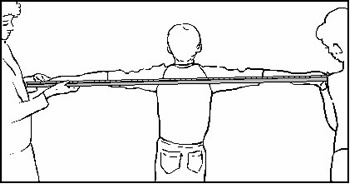
Arm span measurement
The stature of children with involvement of the lower body only (e.g., some children with myelomeningocele or lower body paralysis) can be estimated by using arm-span measurements. This requires the use of a specialized anthropometer.
Note that arms must be perpendicular to body and the anthropometer is touching the extended middle fingers of the right and left hands.
For children with contractures of the upper extremities such as in cerebral palsy, accurate arm span measurements can be difficult.
For typically-developing children, the ratio of arm span to height is about 1:1. This may not be the case for children with special health care needs. Monitoring an individual's arm span measurements over time can provide information about the rate of growth, also known as growth velocity.
Arm span cannot accurately estimate stature in young children (younger than 5 to 6 years) because the proportions of limb length and trunk length to total body length are different for younger than older children.

Arm span measurement
Drawing from: Nardella M, et al. Nutrition Interventions for Children with Special Health Care Needs. WA State DOH, 2001.